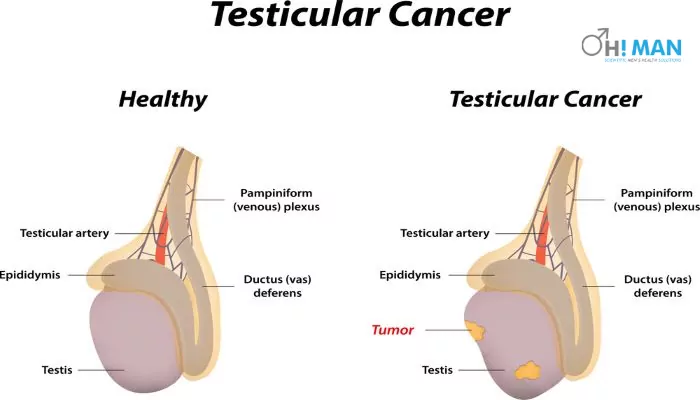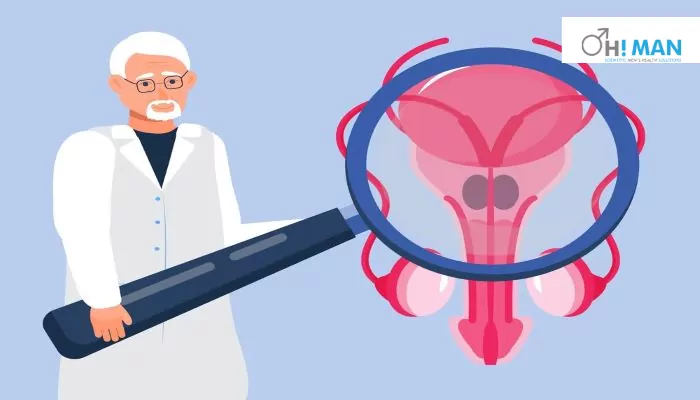What is Testicular Cancer? Symptoms. Causes & Treatment
What is Testicular Cancer? Symptoms. Causes & Treatment

Testicular Cancer begins in the masculine gland, referred to as the testicle or testis. Although it may affect men and boys of any age, it is most prevalent in males aged 15 to 44. It is uncommon and with early detection, testicular cancer is curable. With treatment, the mortality risk associated with this malignancy is minimal.
How effectively a patient responds to treatment depends on the kind of cancer cells, the extent to which the disease has progressed, and the patient’s general condition. When treating testicular cancer, the goal of doctors is to limit treatment-related adverse effects.
To detect this cancer early, men are advised to familiarize themselves with the warning symptoms, understand how to perform a testicular self-exam, and see a physician if they notice a strange lump, swelling, or discomfort in the region.
What Are Testicles?
Testicles are a component of the male reproductive system. These two small egg-shaped organs are in a sac (scrotum) located underneath the penis.
The texture of the testicles is firm and, upon touching, will give a spongy feel. The testicle’s firmness must be uniform throughout. Additionally, the testicles should be identical, although one may be bigger than the other. The epididymis is a rubbery, tube-like structure located at the upper and outside border.
The testicles are the site of sperm maturation. Additionally, the testes produce male hormones like testosterone. So this hormone regulates male sexual desire. Further, it initiates the development of bone, muscle, and other male characteristics.
Table of Content –
Types Of Testicular Cancer
Let us look at the types of primary testicular cancer.
The majority of testicular malignancies originate in the cells producing sperm, and these cells are known as germ cells. There are two primary types: seminomas and nonseminomas.
Seminomas are slow to develop and spread. The two subtypes are:
- Classical seminoma: It is the most frequent and often affects males between 25 and 45.
- Spermatocytic seminoma: The incidence of this kind is highest among older males, and it does not often spread.
Non-seminomas develop and spread faster than seminomas. Typically, they consist of many cancer cells, including embryonal carcinoma. Below a microscope, such cells resemble embryonic tissues like:
- Yolk sac carcinoma: These cells resemble the sac that encases an embryo. This is the most prevalent type of testis cancer amongst children.
- Choriocarcinoma: This is very uncommon and rapidly spreads throughout the body.
- Teratoma: Such cells also resemble embryonic cells.
Germ Cell cancer may begin as intratubular germ cell neoplasia or carcinoma in situ, which does not usually develop into invasive cancer. It is often not accompanied by any testicle tumor or other symptoms, making it challenging to identify.
Stromal tumors are usually benign, although they may be malignant. They account for around 5% of males and 20% of cases in boys. The two types are:
- Leydig cell tumor: This begins in cells that produce male sex hormones. Both children and adults may develop this cancer.
- Sertoli cell tumor: This tumor develops in cells that assist the germ cells.

Testicular Cancer Symptoms
Symptoms of a testicular tumor include:
- A non-painful lump in the testicle
- Testicular enlargement (with or without discomfort) or heaviness in the scrotum.
- Dull aching or agony in the testicles, scrotum, or groin.
- Changes or soreness in the man’s breast tissue
- Back pain
- Fluid collection in the scrotum
- And testicular pain
If you discover a lump or hard section of the testicle, you must see a specialist verify if it is a tumor. A few men with testicular cancer initially experience discomfort.
Many men may not report these symptoms to their physicians. On average, men refrain from speaking for almost months. Since the tumor might progress during this period, it is crucial to contact a specialist if you see any of these symptoms. This is particularly true if the symptom lasts longer than two weeks.
Further, the specialist will determine whether the malignancy is progressing or another problem. Since these symptoms could be due to other conditions, do not panic if you have them. However, plan a consultation with your doctor to be sure. The longer cancer cells have to spread; the more difficult the illness is to cure.
- Epididymitis: An inflammation of the epididymis treated with antibiotics.
- Testicular torsion: In the case of the testicle twist, it may lead to testicular torsion. Usually, surgery treats this condition.
- Hydrocele: Hydrocele is the accumulation of fluid in the scrotum. This often resolves without therapy.
Causes Of Testicular Cancer
Some hereditary factors may raise the chance of testicular cancer. However, doctors aren’t clear on the reason behind testicular cells developing malignant.
The risk factors increasing the probability of developing testicular cancer:
- Age. Approximately half of all occurrences occur in males between the ages of 20 and 30.
- In cryptorchidism, the testicle has not descended.
- a prevalence of testicular cancer in the family
- Being white
- Having HIV might increase the likelihood. A vasectomy doesn’t raise the danger.
Because doctors aren’t still aware of what triggers testicular cancer, and since hereditary factors might contribute, it is impossible to avoid it. An individual cannot change these factors.
Diagnosis Of Testicular Cancer
1. Self-Examination
Often, you can feel a testicular tumor by self-examination, and you must conduct self-examination monthly. So while taking or following a warm bath, you can start with the examination when the skin is relaxed.
- Stand and hold your penis.
- Rotate each testicle softly yet securely across your fingers and thumb, one at a time.
- Examine your testicles for firm lumps or irregularities in their texture.
Remember that one of the testicles being bigger than another is normal. Notify your doctor if you discover a tiny, hard lump, discomfort, or inflammation.
2. Medical Examination
During a typical physical checkup, your doctor examines your testes. So if they suspect that anything is wrong, they may request diagnostic tests to check out other problems or make a diagnosis. These consist of:
- Ultrasound: This method utilizes sound waves enabling to produce the testicles images. It can determine if growths are probable to be cancerous or benign.
- Blood test: Frequently, testicular tumors produce enzymes or proteins that are detectable in the blood. In case you have cancer, the tests may reveal the cancer types you have and the likelihood that it will spread.
- Biopsy: Your doctor might remove a sample of testicular tissue to screen for malignancy. This is known as a biopsy. A biopsy can reveal the presence or absence of malignancy. A testicular tumor biopsied might cause cancer to grow. Therefore, your doctor will probably remove the whole testicle from the scrotum to get a specimen of the tumor.
Following the diagnosis, the doctor may perform CT scans of the pelvis and abdomen to determine whether the cancer is spreading. This method is known as staging.
Stages Of Testicular Cancer
- In Stage 0, testicular cancer is limited to seminiferous tubules, tiny tubes located inside the testicle.
- Testicular cancer is confined to the testicle and adjacent tissues in Stage I.
- In Stage II, cancer has progressed to the abdominal lymph nodes.
- In Stage III, the malignancy has metastasized to outlying lymph nodes or other organs, including the liver, lungs, or brain. The term for this is metastasis.
Testicular Cancer Survival Rate
Testicular cancer has a very good prognosis. Almost all men survive cancer.
No one can predict your precise lifespan since it is contingent on various circumstances, and it varies on individual health, cancer type, therapy, and fitness level.
Your physician may provide further information regarding your prospects (prognosis).
Here are some data By Cancer.org that shows:
- Localized testicular cancer, which has not progressed beyond the testicles, has a 99 percent 5-year survival rate.
- Regional cancer beyond the testicle to the adjacent lymphatic system or other tissues has a 96 percent 5-year survival rate.
- The distanced cancer, which has progressed to the lungs, liver, or lymph nodes far away has 73 percent 5-year survival rate .

Is Testicular Cancer Curable?
Testicular cancer is generally curable even when the malignancy has spread far beyond the testis. Further, depending on the kind and stage of your testicular cancer, you might undergo combination of treatment or even a single treatment.
Below, we will cover the possible testicular cancer treatment.
Testicular Cancer Treatment
Surgery
To identify the stage of the malignancy, one or both testicles and associated lymph nodes are surgically removed. Following surgery, the doctor will plan the treatment.
Radiation treatment
Radiation treatment destroys cancerous cells utilizing high-energy radiation. So it could be internally or externally delivered.
External radiation administration uses a machine that directs the radiation to the diseased region. Internal radiation is administered by inserting radioactive seeds or wires into the afflicted region. Moreover, this method is often effective for curing seminomas.
Chemotherapy
Chemotherapy use drugs to eliminate cancer cells. It is a systemic therapy, meaning it may eliminate cancer cells spread to other body regions. Further when administered orally or intravenously, it may move through the blood and destroy cancer cells.
In cases of highly-progressed testis cancer, high-dose chemotherapy and a stem cell transplant can be a possibility.
Once the chemotherapy destroys the cancerous cell, the doctor would administer stem cells, and they grow to become healthy blood cells.
Following Testicular Cancer Treatment
The chance of testicular cancer recurrence varies depending on the stage of diagnosis. However, it’s pretty low, at around 5% or less. Further, there’s also a modest (around 2%) chance that cancer may spread to the other testicle.
Even so, it’s important to understand how to conduct a testicular self-examination. Regular follow-up appointments with your doctor are also essential, and your diagnosis determines the frequency and duration of follow-up treatment.
If cancer reappears, the physician would want to locate it and address it as soon as possible. Additional therapy depends on the kind of cancer and its region.
Your sexual activity or fertility must not be affected by eliminating one testicle. Following surgery, most men may have a regular erection. However, testicular cancer patients have a greater risk of infertility and lower T-levels. Sperm development may also slow for a short time, and it may be more difficult to ejaculate in case of lymph node removal.
If you’re having trouble ejaculating, some medicines may assist. Consult your doctor if you are concerned. You should also consider utilizing a sperm bank before therapy.
Additionally, your body will adjust over time, and all your bodily functions, including testicular function and sperm production, will be normal.
However, radiation or chemotherapy patients must monitor their heart health. Following treatment, one’s danger of heart disease increases. Yet, a healthy lifestyle will help you avoid these problems.
Final Say
If you observe a difference in one or both testis, don’t wait to see your doctor. Most individuals would like to skip or delay checkups that require a thorough examination of their genitals. However, when it relates to cancer, time is crucial. Further testicular cancer may be cured if caught early enough, depending on the kind of cancer. So, visit the earliest.
In case you are experiencing any fertility issues following your testicular cancer treatment, the experts at Ohman can help you by offering the appropriate fertility treatments. Additionally, you can always book an online consultation with Ohman specialists in case you experience any sexual health concerns.
Frequently Asked Questions
What is one of the first signs of testicular cancer?
The initial indication of testicular cancer involves painless mass or swelling in either of the testicles. Usually, when discovered early, the size of the tumor resembles to a pea or marble. Yet, if left unaddressed, it may grow.
How can you tell you have testicular cancer?
The initial indicators of testicular cancer include a tiny lump or patch of hardness. Check with your doctor if you notice a lump, hardness, enlargement, discomfort, or soreness.
What does testicular cancer feel like?
A good testicle must be smooth with no lumps or bumps. However, testicular tumors might be firm to the touch and can be of various sizes. It may also be sensitive, uncomfortable, or swollen.



